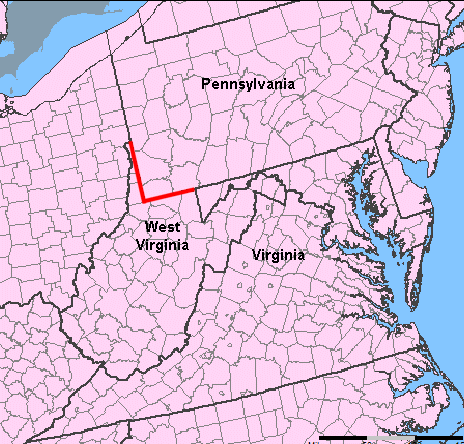
Virginia and Pennsylvania shared a border between 1681-1863
Source: National Atlas

Virginia and Pennsylvania shared a border between 1681-1863
Source: National Atlas
Today there is no common border between Virginia and Pennsylvania - but between 1681 and 1863, the southwestern border of Pennsylvania was shared with Virginia. Exactly what territory was Virginia and what was Pennsylvania was a challenge that took a century to resolve.
The western boundary of Pennsylvania was established in William Penn's 1681 charter. It was dependent upon the longitude of the eastern boundary:1

according to William Penn's charter, the western edge of Pennsylvania was supposed to mirror the curving boundaries on the east so the width of the colony would be a constant five degrees in longitude
Source: David Rumsey Historical Map Collection, New York And Pennsylvania (by Emanuel Bowen, 1758)
William Penn was determined to acquire the Native American claims to his land by legitimate negotiations and purchases, but his efforts to negotiate with fellow Europeans claiming land in North America were even more difficult.
The fundamental problem with Penn's charter was that the point of beginning for his southeastern boundary did not exist. Penn's charter started with the intersection of a circle 12 miles from New Castle (now located in Delaware) and the beginning of the 40th degree of latitude:2
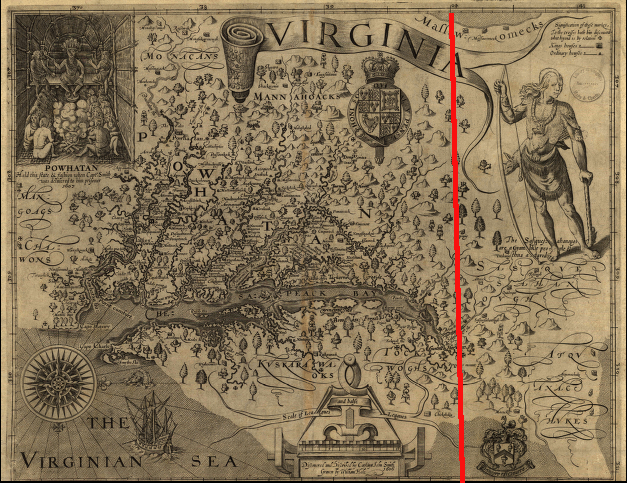
Why King Charles II may have thought the 40th parallel was an appropriate southern boundary for Pennsylvania: John Smith's map located it just at the northern tip of the Chesapeake Bay
(NOTE: Smith's map was oriented with north to the right, and top of the map was the western edge)
Source: Library of Congress, Virginia / discovered and discribed by Captayn John Smith, 1606
However, the 40th degree is so far north of New Castle that the lines never intersect. The geographic impossibility in the 1681 charter created great confusion between the Calverts of Maryland, the Penns of Pennsylvania, and even the gentry of Virginia.
Some Pennsylvania officials tried to expand their claim by asserting that the "beginning" of the 40th degree of latitude was the 39th parallel; therefore all land north of the 39th degree of latitude was included in Penn's grant. That extra degree of latitude would have moved the Maryland-Pennsylvania boundary to the south by roughly 69 miles.3
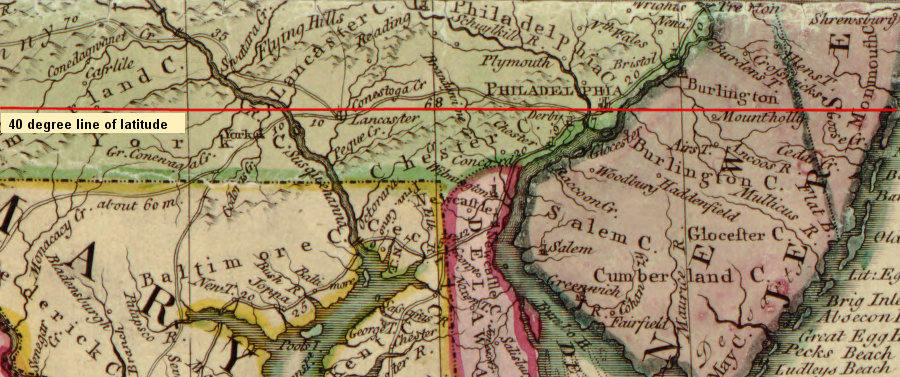
the 40th degree line of latitude runs through Philadelphia, and does not intersect a circle with a 12 mile diameter centered on New Castle
Source: Library of Congress, A map of the British and French dominions in North America, with the roads, distances, limits, and extent of the settlements
The southwestern corner of Pennsylvania was defined by Penn's charter; it was five degrees of longitude to the west of the southeastern corner. Until the eastern and southern boundaries of Penn's colony were defined, however, it was impossible to establish the western edge - and without accurate clocks, measuring longitude accurately on the frontier was a challenge.
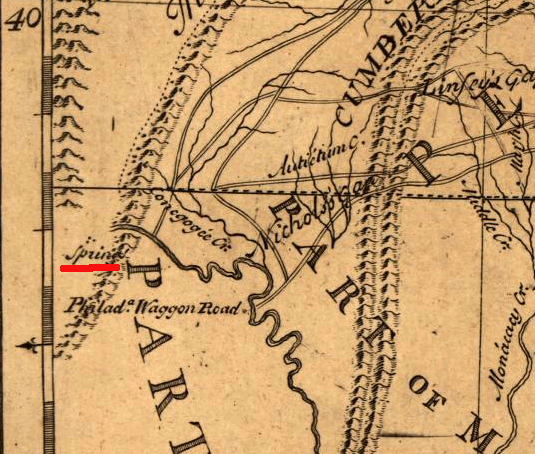
40th degree of latitude and spring at head of Potomac River, landmarks which defined the future Maryland-Pennsylvania-Virginia borders
Source: Library of Congress, A map of Pensilvania, New-Jersey, New-York, and the three Delaware counties (by Lewis Evans, 1776)
The confusion among the colonists and officials in London was minor compared to the threat from the French. That nation had explored the Mississippi River and claimed its watershed, including the lands where water flows into the Ohio River, since René-Robert Cavelier, Sieur de La Salle, canoed downstream and reached the mouth of the Mississippi River on April 9, 1682.
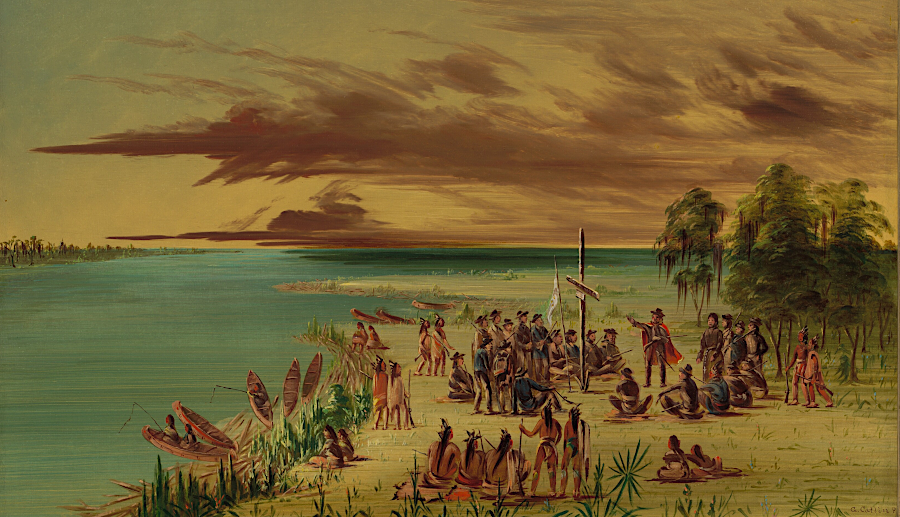
La Salle established the French claim to the Ohio River watershed in 1682 when he reached the mouth of the Mississippi River
Source: National Gallery of Art, La Salle Claiming Louisiana for France. April 9, 1682 (by George Catlin, 1847-48)
The French did not accept the western land claims of Penn or Calvert. To the King of France, there was no validity to the Virginian claim that King James I's Second Charter in 1609 granted them land "from sea to sea" and thus control over most of the Ohio River watershed.
England and France were rivals for control of land and the North America fur trade since the start of the 17th Century. French-English competition extended inland from the fishing fleets on the Grand Banks off Newfoundland to the Ohio River Valley.
The 1748 Treaty of Aix-la-Chapelle settled the War of Austrian Succession, one of the many French/English conflicts in Europe. North America was a minor sideshow in what was known as King George's War. The treaty negotiators who ended the conflict were more concerned with Europe, and failed to resolve the claims of Virginia to lands that the French also claimed in North America.
During King George's War, the colonists had captured Louisbourg (a French fortress on Cape Breton Island in Nova Scotia) with assistance from the British Royal Navy. This was a big deal in North America; it gave the English control over the valuable fishing grounds near Newfoundland.
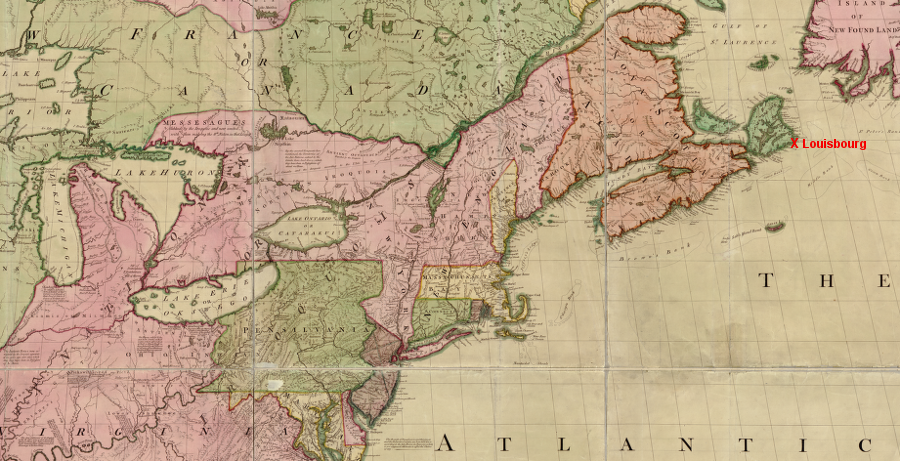
Louisbourg was far from Virginia, but its return to France in the 1748 Treaty of Aix-la-Chapelle indicated how British officials focused on reducing the French threat in Europe and viewed North America as a secondary theater
Source: Library of Congress, John Mitchell, A map of the British and French dominions in North America, with the roads, distances, limits, and extent of the settlements (1755)
The Treaty of Aix-la-Chapelle negotiators in Europe undid the capture. The treaty restored that fortress to France in exchange for territory captured by the French in India and Europe. The return of Louisbourg and the failure to resolve French claims to the Ohio River Valley, made clear that English officials based in London considered the western extent of the American colonies to be just a subordinate boundary issue in international negotiations.
The French planned to expand their control of lands west of the Alleghenies. When English explorers were just beginning to penetrate lands west of the Shenandoah Valley in the 1740's, the French took action to link their outposts along the St. Lawrence River to other French settlements at the mouth of the Mississippi River and upriver in the Illinois country.
In 1749, Captain Bienville de Celeron canoed from Montreal down the Ohio River and then back up the Miami River to Lake Erie. The French buried lead plates on the Ohio River at various confluences with major creeks, while shouting "Vive le Roi" to establish the claim of the King of France to the Ohio River watershed. Perhaps more importantly, de Celeron chased British traders away from Native American villages.4
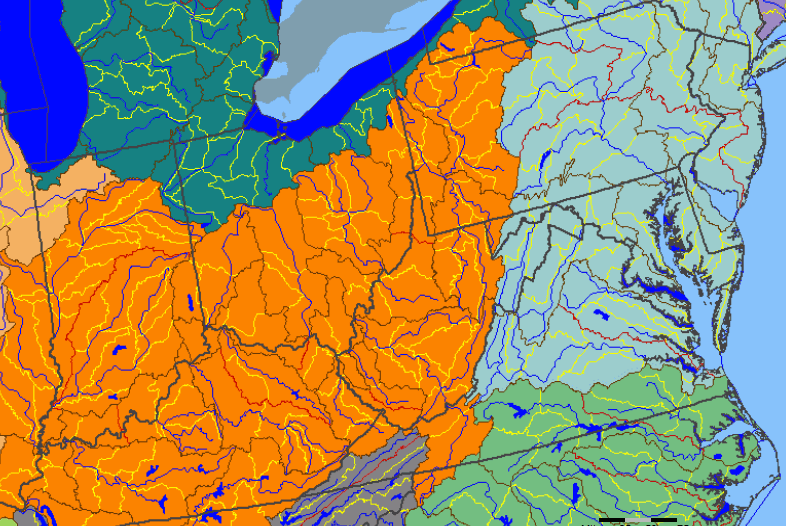
Ohio River watershed (in orange)
Source: National Atlas
The French planned to build a series of forts along the Ohio River, extending supply lines from Quebec/Montreal on the St. Lawrence River. This would trap the English colonies along the Atlantic Ocean, blocking any expansion west into the Ohio River/Mississippi River watersheds.
French plans were triggered in part by plans of Virginians to expand into the same region. In particular, in 1749 the Lords of Trade in London approved a grant to the Ohio Company for up to 500,000 acres west of the Allegheny Mountains.
The company was formed by members of the Virginia gentry, who wisely included Governor Dinwiddie and the influential merchant in London John Hanbury. Under the terms of the initial grant, in exchange for settling 100 families and building a fort within seven years, the company would earn its first 200,000 acres.
Thomas Lee, a member of the Ohio Company, was Acting Governor in Virginia in late 1749 after Governor William Gooch returned to England. Lee wrote the governor of Pennsylvania to about the Ohio Company's plans to "to erect and Garrison a Fort to protect our trade (from the French) and that of the neighboring Colonies, and a month later added in another letter:5
In preparation, the Ohio Company sent Christopher Gist to explore around the Forks of the Ohio in 1750 and established a field headquarters/fort at Wills Creek (now Cumberland, Maryland). In 1752, the Ohio Company got the original 1749 land grant terms altered by the Lords of Trade. The company committed to settling 300 families and building two forts, in exchange for removal of any deadline and for granting the entire 500,000 acres. Location of the land grant was specified in 1752 as:6
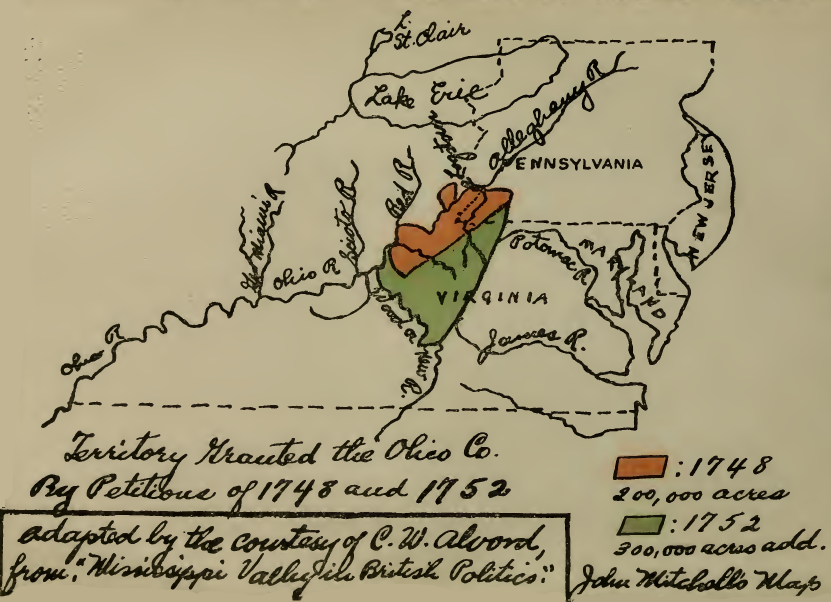
the Ohio Company, a syndicate of land speculators including key officials in Virginia, obtained rights to survey and sell 500,000 acres in the Ohio River watershed between the Allegheny River and the Kanawha River (including its tributary, the New River)
Source: The Ohio Company, a colonial corporation (facing title page)
The Virginians most concerned about Captain Bienville de Celeron and the French claims were the members of the Ohio Company land syndicate. Shareholders included Thomas Lee, president of the Governor's Council, and Governor Dinwiddie himself. Lawrence Washington was a member until he died from disease in 1752. In 1753, Governor Dinwiddie chose Lawrence's half-brother George to travel to the French fort near Lake Erie during the middle of winter and direct the French to leave the Ohio River.
Viewed from Williamsburg, the Ohio River was in Virginia rather than in Pennsylvania. Joshua Fry and Peter Jefferson updated their map of Virginia throughout the 1750's to include information acquired from Gist's journeys and later during the French and Indian War, but always indicated that the Virginia boundary was east of the Forks of the Ohio. That placed the Ohio Company's fort (later Fort Duquesne, Fort Pitt, and finally Pittsburgh) in Virginia.
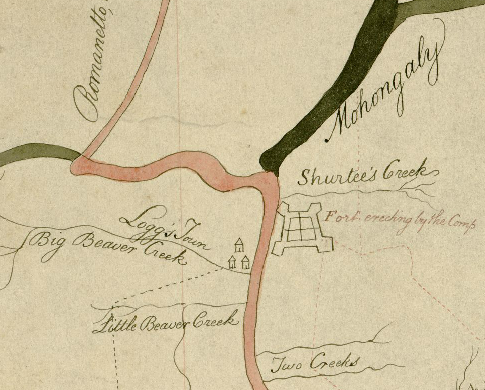
the Ohio Company started to build a fort at the Forks of the Ohio, but the French seized it and completed Fort Duquesne
Source: University of Pittsburgh - Darlington Digital Library, Part of the Ohio River... and the courses of Christopher Gist's first and second tours
A map produced by the father of Patrick Henry in 1770 repeated the Virginia claim that Fort Duquesne/Pittsburgh was west of the Virginia-Pennsylvania boundary.
In England, John Mitchell produced a different map in 1755 to display the English claims on the North American continent. It too identified the lands west of Pennsylvania as "Virginia." The Mitchell map also colored the lands west of the Mississippi River to show Virginia owned the lands between the 36° 30' parallel of latitude and the 40° parallel.
Virginia's control to the Pacific Ocean was defined in the Second Charter in 1609, issued by King James I. The boundary on the north was limited by the 1620 New England charter and later grants to others. Mitchell's map acknowledged Virginia's claims to lands west of Pennsylvania and east of the Illinois river, accepting the Ohio Company's grant, but did not indicate Virginia owned lands above the 40° parallel west of the Illinois River. On the south, Virginia's boundary was defined at the 36° 30' parallel by the 1665 grant of North Carolina to the eight proprietors.
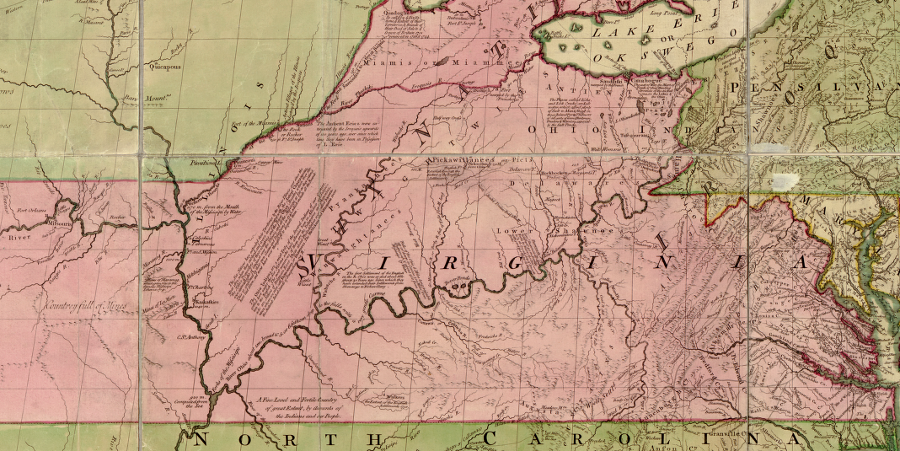
on the 1755 Mitchell map, lands west of the Ohio River and north to Canada were identified as part of Virginia
Source: Library of Congress, John Mitchell, A map of the British and French dominions in North America, with the roads, distances, limits, and extent of the settlements
However, Mitchell disagreed with the maps produced by Virginians and placed the Forks of the Ohio within the boundaries of Pennsylvania.
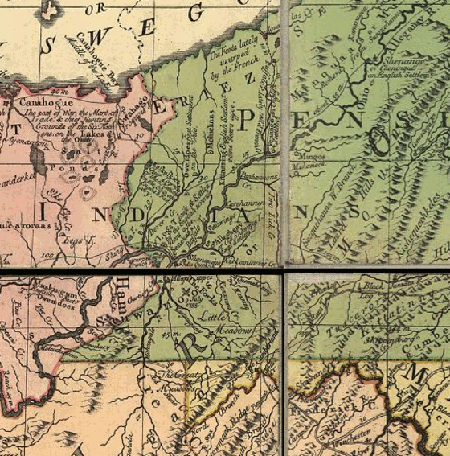
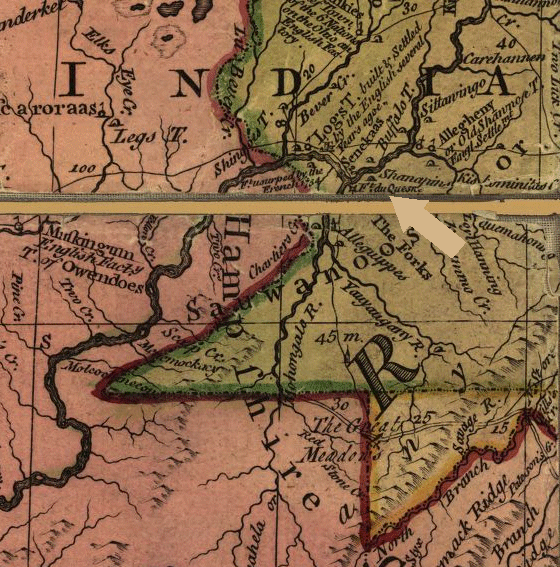
the 1755 Mitchell map did not accept Virginia's claim to the Forks of the Ohio - and did not define western Pennsylvania's boundary by a line of longitude 5 degrees west of the eastern boundary of that colony
Source: Library of Congress, John Mitchell, A map of the British and French dominions
in North America, with the roads, distances, limits, and extent of the settlements
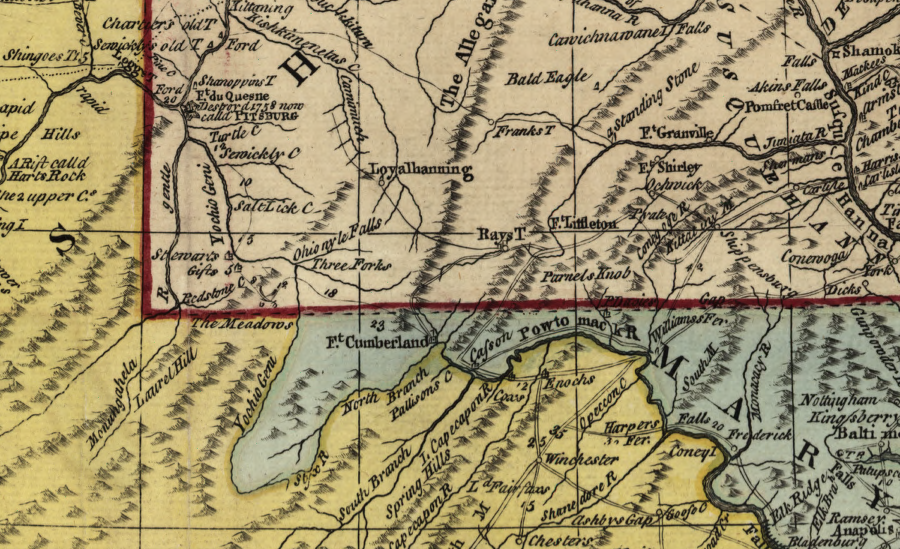
a 1771 version of the Lewis Evans map made clear that Pennsylvania included the Forks of the Ohio
Source: Library of Congress, Lewis Evans, A general map of the middle British colonies in America (1771)
The Virginia claim to the confluence of the Allegheny and Monongahela rivers (the "Forks of the Ohio River") was the Second Charter issued by King James I in 1609 plus the 1744 Treaty of Lancaster with the Iroquois. During the treaty negotiations, the Iroquois claimed their controlled lands west of the Allegheny Mountains by right of conquest:
The Virginians claimed to have purchased those Iroquois rights in the 1744 Treaty of Lancaster. In the 1750's, colonial officials in Williamsburg were willing to assert Virginia's ownership through multiple claims, including right of conquest, initial settlement, and royal grants.
The French, of course, did not feel obliged to honor any English claims. French military expansion into the Ohio River Valley would block the claims of any English colony to the land. French occupation, starting with forts and traders and ultimately settlers, would ensure continued French control over trade with the Native Americans west of the Alleghenies.
The pacifist Quakers in the Pennsylvania legislature were unwilling to raise taxes to confront and potentially fight the French. In contrast, the Virginians were willing to assert their land claims and aggressive in their behavior towards the French.
In late 1753, Governor Dinwiddie sent an emissary in the middle of the winter to tell the French to abandon their plans to build a string of new forts from Lake Erie down into the Ohio River valley. That emissary, an ambitious young man named George Washington, carried a specific message from Governor Dinwiddie to the French while they were camped at Fort Le Boeuf south of Lake Erie:8
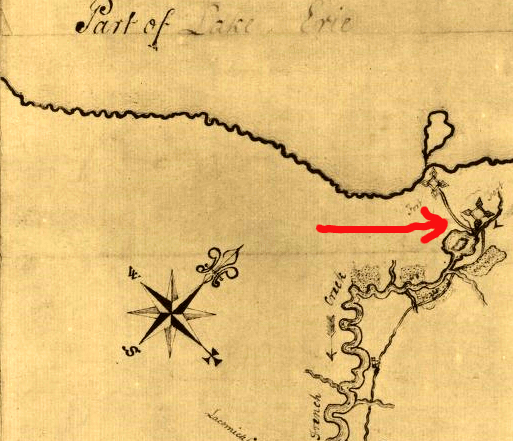
George Washington's map showing Fort Le Boeuf, near Lake Erie
Source: Library of Congress, George Washington's map, accompanying his "journal to the Ohio", 1754
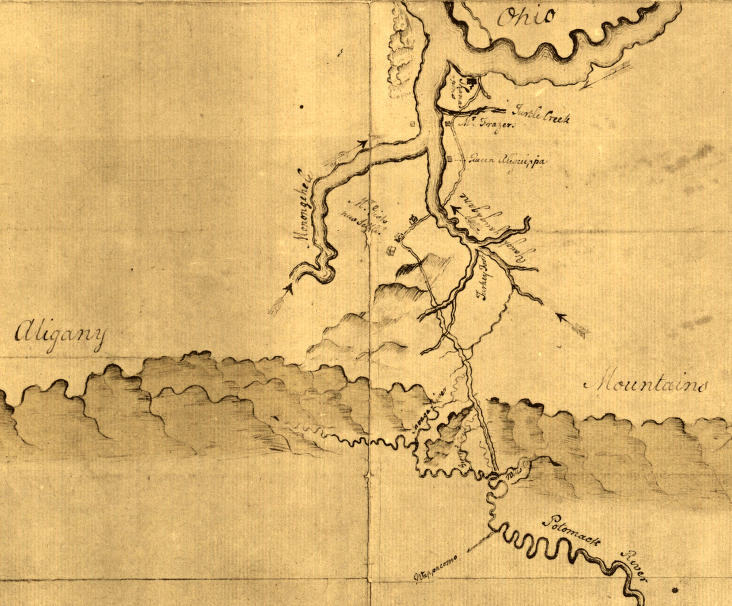
George Washington's path across the Potomac-Ohio watershed divide to Fort Le Boeuf
Source: Library of Congress, George Washington's map, accompanying his "journal to the Ohio", 1754
Washington relied upon Christopher Gist and a few Native American guides to cross the wilderness and reach Fort Le Boeuf. He was well treated by the French officers there, led by Legardeur de St. Pierre. The French officials, camped in the middle of nowhere during the cold winter, must have been entertained by the company of a young, smart, and well-spoken representative from Williamsburg.
Washington had no military force with him, and no leverage. The French sought to recruit his Native American allies, and may have succeeded in getting one to try to murder Washington during the trip home.
Virginia protests failed to convince the French that they should alter their strategic initiative to occupy the Ohio River Valley. The French politely rejected all of the English claims to the Ohio River and proceeded to implement their plans, moving downstream in the spring of 1754.
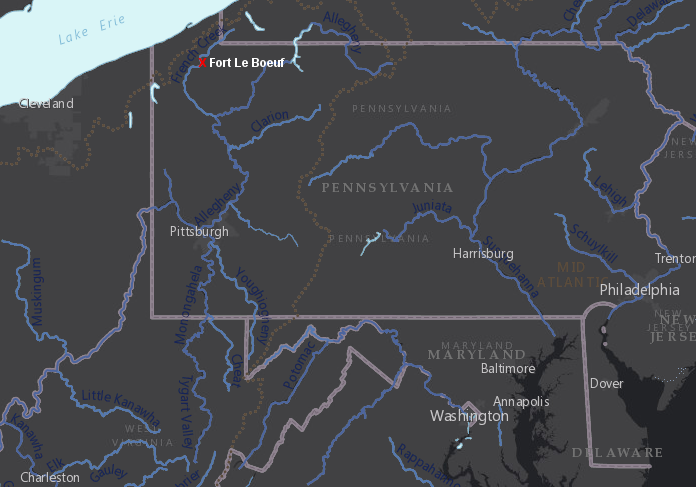
Fort Le Boeuf was built 15 miles from Lake Erie, across the watershed boundary on a tributary of Allegheny River near modern-day Waterford, Pennsylvania
Source: ESRI, ArcGIS Online
The French quickly ejected the Ohio Company representatives trying to build Fort Prince George at the Forks of the Ohio. The French built their own Fort Duquesne on that site, advancing the occupation of the Ohio Country initiated with the 1749 expedition of Captain Bienville de Celeron burying lead plates down to the mouth of the Miami River.
Later in 1754, Joshua Fry led the Virginia Regiment on a military expedition to the forks to protect the Virginians and establish an English presence at that strategic location. However, Fry died after falling off his horse and young George Washington assumed command of the Virginia Regiment of Provincial Regulars. He led the colonial military expedition into major failure, both militarily and diplomatically.
Washington attacked a French unit encamped in a Pennsylvania valley (now called Jumonville Glen) away from Fort Duquesne. In the attack, the Virginians killed nearly all of the French, including their leader Joseph Coulon de Villiers de Jumonville. Washington retreated to Great Meadows and erected his own defensive "Fort Necessity" to repel the French military response.
It was a poor tactical decision to stop rather than to keep retreating. After the French and their Indian allies attacked the fort, Washington had to surrender it. As part of the surrender, he signed a document in French (a language he did not read...) that said he had assassinated de Jumonville.
This incident helped to trigger the French and Indian War (or the Seven Years War, as it was known in Europe). The war was an imperial conflict that stretched from India to the Caribbean - and north to Canada.
In 1755, England sent two regiments across the Atlantic Ocean, led by General Braddock, to fight the French and defend colonial land claims. Braddock's expedition from Alexandria to Fort Duquesne was a failure. He was defeated by the French and their Indian allies on the outskirts of the fort. In that battle, Braddock and the opportunity for Virginia to control the Forks of the Ohio both died.
In 1758, the British under John Forbes finally captured Fort Duquesne and renamed it Fort Pitt. Much to the frustration of the Ohio Company and other land speculators in Virginia, Forbes' army in 1758 had been organized in Pennsylvania. His march westward across the colony established good roads that connected Philadelphia to the Ohio River and created a shorter, better road than the trail used by General Braddock on his expedition from Virginia. As Forbes reported back to London:9
Trade on Forbes' new road between Philadelphia and Pittsburgh undercut the Virginia colony's economic links up the Potomac River to the Ohio. If Braddock had captured Fort Duquesne and the Ohio Company had placed settlers in the Allegheny and Monongahela river valleys, Virginia might have established de facto economic and military control of the upper Ohio River Valley. If "possession is 99% of the law," then Virginia may have been able to repulse the legitimate land claims made by Pennsylvania based on the boundaries defined in Penn's 1681 charter.
Instead, Virginia's western boundary was reduced in the 1763 Treaty of Paris at the end of the Seven Years War (known as the French and Indian War in North America). The French surrendered their claims to land on the North American continent, and in the treaty the Mississippi River was defined as the western edge of Virginia. The Spanish ended up with Louisiana, including New Orleans.
During the French and Indian War, the pacifist Quakers who had controlled Pennsylvania's government were replaced by assertive colonial leaders. The Penn family ended up paying the equivalent of taxes for defense expenses. The new colonial leaders ensured the Pennsylvania boundaries were established clearly, and acquired authorization from the Iroquois in the 1768 Treaty of Fort Stanwix to expand settlement westward to the Ohio River.
Pennsylvania and Maryland officials resolved their disputed boundaries through a 1763-67 survey by two Englishmen, Charles Mason and Jeremiah Dixon. The line they drew became the basis for locating the southern boundary of Pennsylvania. Defining the southeast corner of Pennsylvania finally defined the Pennsylvania-Virginia boundary west of Maryland.
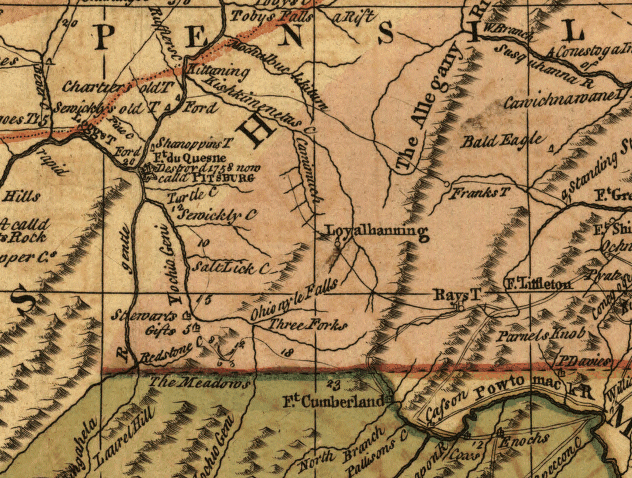
the original Lewis Evans map showed an extension of the Mason-Dixon line westward, serving as the Virginia/Pennsylvania border
Source: Library of Congress, A general map of the middle British colonies in America
Ever since the proprietary grant to William Penn in 1681, the border between Virginia and Pennsylvania had depended upon defining the eastern edge of Pennsylvania and the southern boundary. The 40th degree of latitude was more than 12 miles north of New Castle, so the key location in Penn's charter to define his boundaries did not exist. Once the eastern and southern edges of Pennsylvania was resolved, however, surveyors could locate a north-south line "five degrees in longitude, to bee computed from the said Easterne Bounds" to mark the western edge of Pennsylvania.
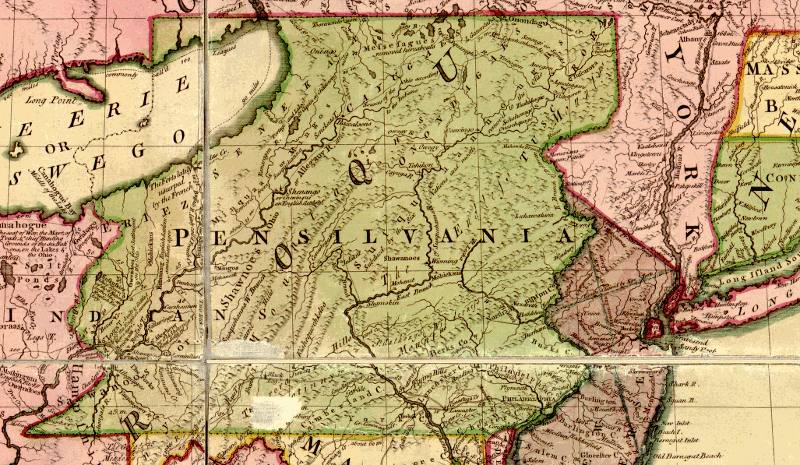
colonial boundary claims of Pennsylvania vs. New York, 1755 (Pennsylvania extends to 43rd degree of latitude, but also extends south of 40th degree running through Philadelphia...)
Source: Library of Congress, A map of the British and French dominions in North America, with the roads, distances, limits, and extent of the settlements
While the western boundary was still unclear, land speculators in Virginia chartered the Ohio Company, speculators in Pennsylvania chartered the Indiana Company, and speculators in Maryland formed the Illinois and Wabash companies. Their claims overlapped each other.
The French and Indian War delayed resolution of the Ohio Company's claims, which the Virginians had sought to confirm in 1749 through a boundary survey. When the war ended, the Calverts of Maryland and the Penns of Pennsylvania hired two "neutral" surveyors from England to survey the southern boundary of Pennsylvania/northern boundary of Maryland.
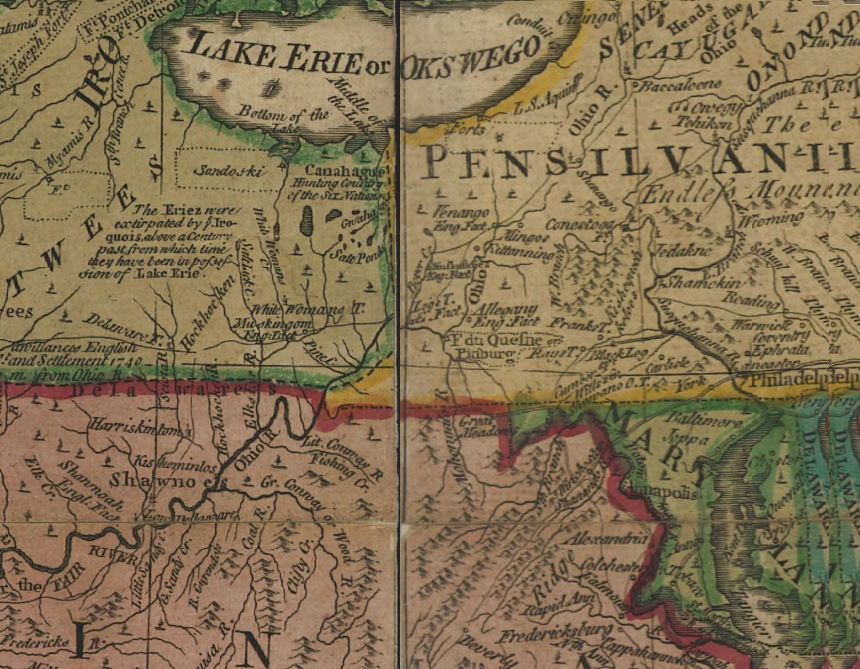
a map prepared after the end of the Seven Year's War accepted Pennsylvania's claim to lands west of Pittsburgh
Source: Library of Congress, An accurate map of North America (by Emanuel Bowen, 1763)
Charles Mason and Jeremiah Dixon spent four years (1763-1767) marking the location of the colonial boundaries with monuments on the ground. They started by identifying a spot 15 miles south of Philadelphia, setting a "Post marked West." That established a point of beginning, accepted by Penns and Calverts as the appropriate latitude for their dividing line.
In 1764 they defined the western border of Delaware, separating it from Maryland. In 1765, the two surveyors returned to the "Post marked West" and began to pull the 66-foot chain to define more of the West Line. When they reached North Mountain at modern Hancock, they determined that Maryland would be two miles wide at that point.
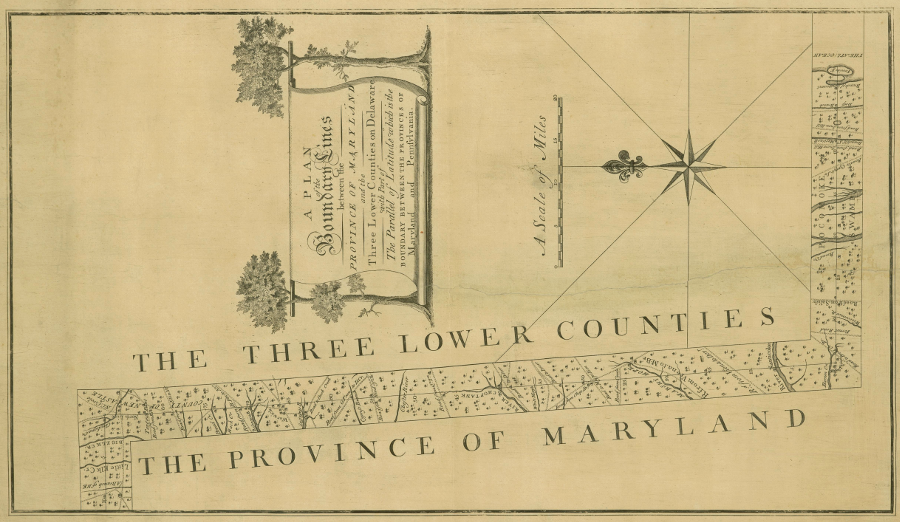
Charles Mason and Jeremiah Dixon surveyed the boundary between Maryland, Pennsylvania, and Virginia
Source: John Carter Brown Library at Brown University, A Plan of the Boundary Lines between the province of Maryland and the Three Lower Counties on Delaware (Charles Mason, 1768)
In 1766, they surveyed east from the "Post marked West" to the Delaware River. Penn's charter defined the western edge of the colony to be five degrees west of the eastern edge, and that point on the Delaware River ultimately determined the southwestern corner of Pennsylvania separating it from Virginia. Mason and Dixon also returned in 1766 to North Mountain and surveyed further west to Little Allegheny Mountain, the line today that separates Somerset and Bedford counties in Pennsylvania. Each mile, they set a monument stone to mark the boundary.
Mason and Dixon finished surveying the West Line in 1767 and soon reached a point due north of the headwaters of the Potomac River. Maryland's western border was defined by a north-south line between the "headspring" of the Potomac River (marked by the Fairfax Stone in 1746) on the south and the Mason-Dixon line on the north. West of the headspring, Mason and Dixon were no longer defining the Pennsylvania-Maryland boundary; they began defining the boundary between Pennsylvania and Virginia.
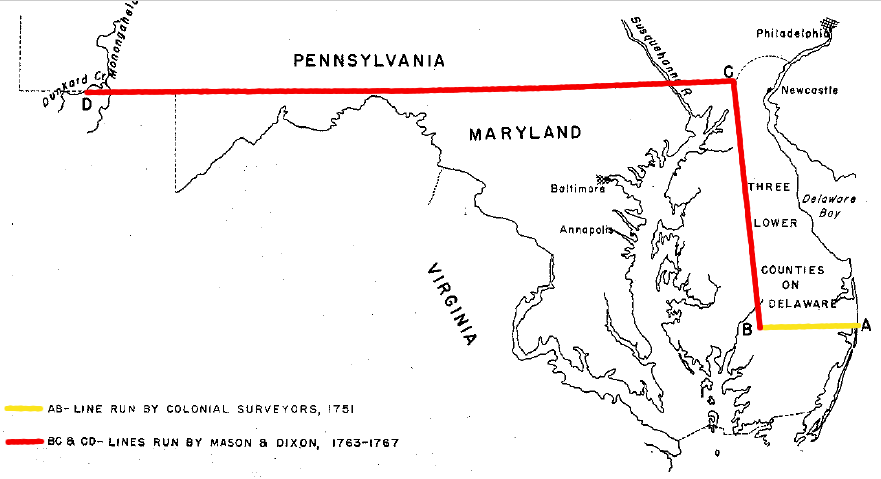
Mason and Dixon were paid by the Calverts and Penns to survey the boundary between Maryland and Pennsylvania, but continued past the western edge of Maryland and defined a portion of the Virginia-Pennsylvania border
Source: Maryland Board of Natural Resources, The Maryland-Pennsylvania and The Maryland-Delaware Boundaries (Figure 9)
Mason and Dixon stopped on October 9, 1767 at Dunkard Creek. After the 1744 Treaty of Lancaster, that stream marked the "War Path" of the Iroquois who traveled south to attack Cherokee and the Catawba. Mason and Dixon were unable to complete their east-west line and determine the southwestern corner of Pennsylvania because, west of their War Path, the Iroquois refused to provide protection against possible attack by Native Americans who identified as Shawnee, Delaware and Mingo.
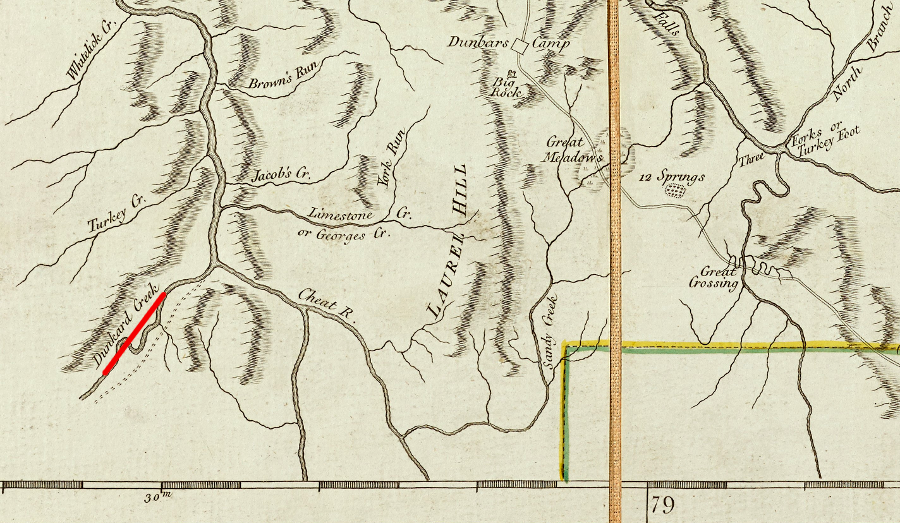
Mason and Dixon stopped at Dunkard Creek, and did not survey to the southwestern corner of Pennsylvania
Source: John Carter Brown Library at Brown University, A map of Pennsylvania exhibiting not only the improved parts of that Province, but also its extensive frontiers (Robert Sayer and John Bennett, 1775)
The surveyors were 233 miles west of their point of beginning. Dunkard Creek is 33 miles west of the Maryland border and 22 miles east of the point that is now the southwestern edge of Pennsylvania. West of Sideling Hill, the surveyors used mounds of earth rather than stone monuments to mark the boundary between British colonies.10
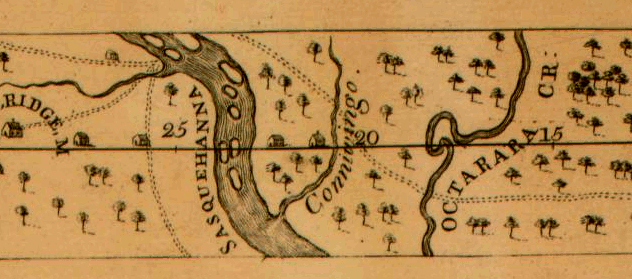
portion of Mason-Dixon line delineating Maryland from Pennsylvania
Source: Library of Congress - Charles Mason, 1768,
A plan of the west line or parallel of latitude, which is the boundary between the provinces of Maryland and Pensylvania
The endpoint of the Mason-Dixon line was thought to be 36 miles east of the line that would be "five degrees in longitude... computed from the said Easterne Bounds." That left enough land to the west, and enough confusion about the boundary lines in the southwestern corner of Pennsylvania, for assertive and land hungy Virginians to claim the rights to property that may have been located in Virginia - or maybe not.
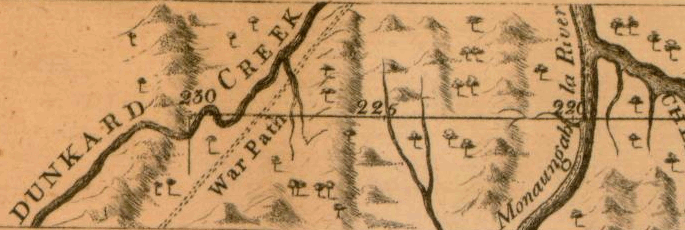
Mason and Dixon crossed the Monongahela River and quit surveying at Dunkard Creek
Source: Library of Congress - Charles Mason, 1768,
A plan of the west line or parallel of latitude, which is the boundary between the provinces of Maryland and Pensylvania
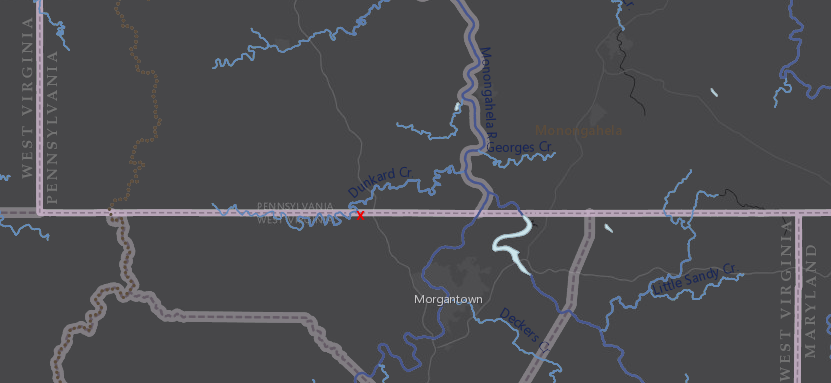
the western end of the Mason-Dixon Line is north of modern Morgantown, West Virginia
Source: ESRI, ArcGIS Online
Virginia officials continued to say the Forks of the Ohio were within their colony, not in Pennsylvania. Land speculators associated with the Ohio Company and the Walpole Company, which sought a grant for Vandalia, asserted their right to sell land on the Ohio River up to the confluence of the Allegheny and Monongahela rivers.
Back in 1749, trader and interpreter George Crogan had gotten Iroquois chiefs to give him the rights to 200,000 acres in the Ohio River Valley. Crogan was a negotiator between British/colonial officials, other traders, and Native American groups in western Pennsylvania.
His claim to the land had thin justification; British and colonial policies prohibiting recognition of private land sales by Native American tribes. Despite the prohibition, Crogan repeatedly asserted in various settlings that he was entitled legally to the 200,000 acres. In the absence of clearly legitimate authority by either Pennsylvania or Virginia to sell land and guarantee title, Crogan proceeded to open a land office in 1770 and convinced some settlers to pay him for land around Fort Pitt.
Land ownership in the area was complicated by the actions of Lord Dunmore in Williamsburg. In 1773 he ordered a surveyor, William Bullitt, to mark off parcels so Virginia could start awarding the land grants it had promised to soldiers who enlisted in the First Virginia Regiment.
Back in 1754, Governor Dinwiddie had proclaimed that 200,000 acres would be set aside on the Ohio River for men willing to join the Virgia Regiment. At the end of the French and Indian War, the Proclamation of 1763 had blocked western settlement and prevented Williamsburg-based officials from approving surveys and patenting land in the Ohio River watershed. Until Dunmore ordered Bullitt to start surveying in 1773, Colonial officials in Virginia had not identified where veterans of the French and Indian War who qualified for the recruitment land bounty (or land speculators who had purchased those rights) could claim their acres.
As Colonel of the First Virginia Regiment, George Washington was entitled to the largest land bounty. He could afford to make risky investments in land that might not produce income for many years, while most Virginia Regiment recruits desired a quicker reward for their service. Washington acquired the rights of many veterans who did not want to wait for the British and colonial governments to sort out how to make good on Governor Dinwiddie's 1754 promise.
In 1769, in advance of Lord Dunmore's 1773 action, Washington arranged for the Virginia Executive Council to authorize surveying and patenting the 200,000 acres promised to those who enlisted in the Virginia Regiment in the French and Indian War. At an August 2, 1770 meeting in Fredericksburg, other investors who acquired large numbers of military warrants agreed to finance the surveys required to define parcel boundaries and obtain land deeds (patents). To avoid conflict with existing settlers, separate land speculators actively claiming land near the Forks of the Ohio, and Pennsylvania officials, the investors who met in Frederickburg chose to survey land farther west in the Kanawha River valley.
In October 1770, Washington personally started surveying along the Kanawha River. With him were his friend and physician Dr. James Craik and a surveyor, George Crawford. Washington had acquired the rights to 40,000 acres, and he raced out west after the Fredericksburg meeting to identify the best parcels for himself. In the mountains of western Virginia, flat bottomland with springs that could water corn, wheat, and other crops was far more valuable than steep mountain slopes that were suitable for just grazing cattle and hogs.
Washington also purchased 15,000 acres near the Forks of the Ohio. Land surveys there overlapped with each other, including George Crogan's surveys; getting clear title was not a simple process. Settlers had to choose who to pay for land. Some simply decided to squat and start a farm first; they would wait to pay for the land later, once it was clear how to establish legal title. Paying George Crogan, George Washington, or some other Virginian might be a waste if a parcel ended up within the boundaries of Pennsylvania, because a new survey and new payment would have to be processed by a Pennsylvania land office.11
Virginia officials and land speculators claimed the Forks of the Ohio had been seized by the French and recaptured by the British army under General Forbes in 1758. Even if the western boundary of the Pennsylvania charter extended beyond Fort Pitt, Virginians claimed that under the Right of Conquest the British Crown had regained authority over the western lands. Based on that tenuous claim, the western Pennsylvania boundary defined in the colony's charter was void.
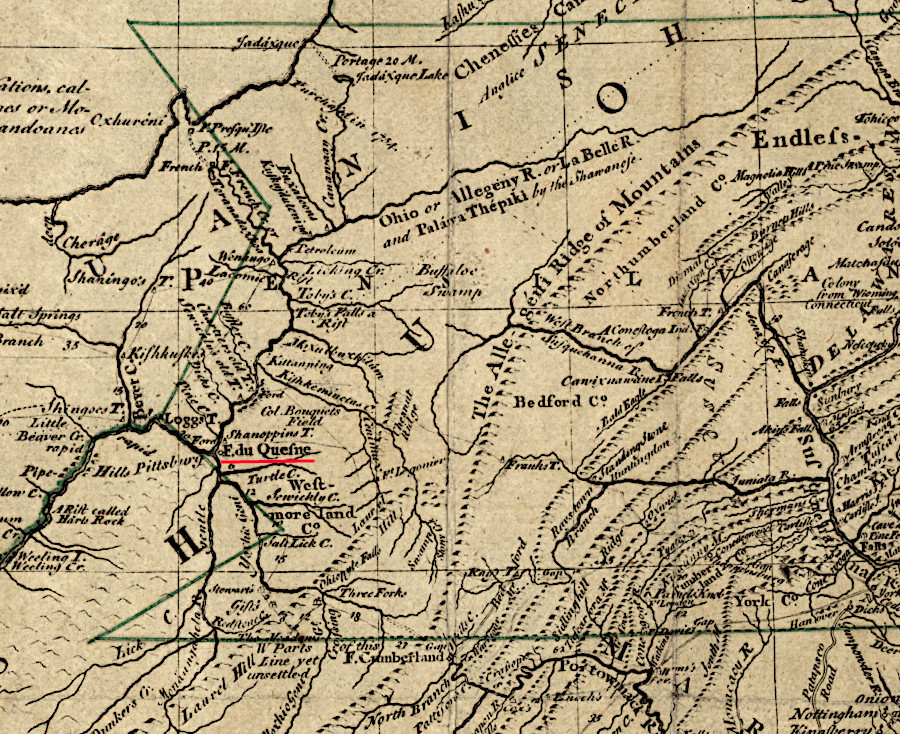
a jagged western boundary (green line) would have given Virginia much of southwestern Pennsylvania but not Fort Duquesne
Source: Library of Congress, A map of Pensilvania, New-Jersey, New-York, and the three Delaware counties (by Lewis Evans, 1776)
Pennsylvania created Westmoreland County in 1773. That action established in the southwestern corner of the colony a local court that could process surveys and land patents. Settlers loyal to Pennsylvania dealt with local officials appointed by the Pennsylvania General Assembly, or elected locally in Pennsylvania-sponsored elections, for legal and political decisions.
Philadelphia-based land speculators competing with Virginia land speculators sought to obtain rights to land along the Ohio River through British officials in London. The Philadelphia speculators acquired the claims of "suffering traders" whose goods shipped to backcountry trading sites, had been seized by Native Americans and their French allies at the start of the French and Indian War or during Pontiac's War in 1763.
In the negotiations that led to the 1768 Treaty of Fort Stanwix, the Iroquois agreed to compensate the suffering traders with rights to "Indiana," a large chunk of land somewhere west of the Monongahela River. That treaty also ceded to the British government the questionable Iroquois claim to land south of the Ohio River, clearing title to Kentucky for Virginia's land speculators such as the Loyal Land Company and the Ohio Company. However, the 1768 treaty did not grant to the British any of the Native American claims to land north of the Ohio River, and the 1763 Proclamation Line still banned settlement west of the Allegheny Front.
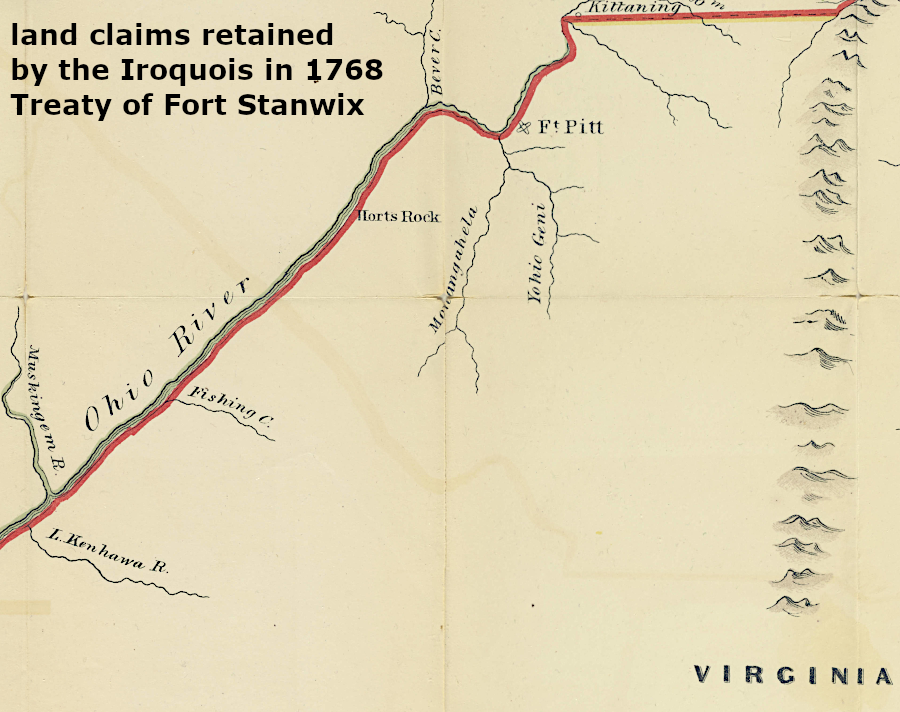
the 1768 Treaty of Fort Stanwix did not authorize settlement west of the Ohio River by people from either Virginia or Pennsylvania
Source: Penn State, Map of the frontiers of the northern colonies : with the boundary line established between them and the Indians at the treaty held by S. Will Johnson at Ft. Stanwix in Novr. 1768
The attempt to establish Indiana, which investors eventually transformed into the proposal for the Vandalia colony, was in direct conflict with the 1749 grant issued in Williamsburg to the Ohio Company. Virginia investors in the Ohio Company had the right to 500,000 acres of western land located south of the Ohio River
Pennsylvania-based land speculators outmaneuvered the Virginians in London and in 1773 got initial authority from the Privy Council to create Vandalia. The Ohio Company investors decided to join rather than fight the Walpoles and others from Philadelphia. The Ohio Company investors ended up owning only two of the 72 shares, but that would have totaled over 500,000 acreas because the Vandalia group ended up asking for 20,000,000 acres of land in what today is West Virginia and Kentucky. Unfortunately for the Pennsylvanians and the Ohio Company, the American Revolution eliminated all British-approved claims to Vandalia and the colony never opened the planned land office at Fort Pitt.12
The British abandoned Fort Pitt in 1772. After the French left North America in 1763, the fort was no longer on the edge on an international frontier. Its function after 1763 was to be a supply base that provided support to Fort Chartres on the Mississippi River. From a military perspective, Fort Chartres served as a defense installation of the edge of Spanish Louisiana west of the river. The British also hoped that it would attract settlers and stimulate the economy in the western lands won in the French and Indian War.
Fort Chartres failed to become self-sufficient. General Gage, the British commander in North America, recommended closing it and Fort Pitt in 1771 in response to direction from London to reduce costs. Officials in London concurred and Fort Pitt was sold in 1772.
Beginning in 1775, Col. John Neville and the militia from Frederick County, Virginia occupied the site of Fort Pitt, renaming it Fort Dunmore. Lord Dunmore issued a proclamation affirming the Virginia claim to the territory and the General Assembly designated it as the District of West Augusta. Settlers loyal to Virginia living in the area had the option of relying upon a separate, parallel system of Virginia officials for taxes, elections, and lawsuits.
Dunmore then appointed Dr. John Connolly as local captain of the Virginia militia. Connolly was aggressive in asserting his authority, and Westmoreland County (PA) officials arrested him. In turn, he collected 200 Virginia militia and arrested Pennsylvania officials who exercised their authority.
In 1775 Lord Dunmore and the General Assembly created the District of West Augusta, rather than a county. Creating a "district" minimized conflict with the Proclamation of 1763 issued by King George III. That proclamation had blocked new settlement west of the Alleghenies, at least in theory.
In 1776, after Virginia abandoned efforts to appease British officials, the General Assembly formally created three separate counties (Yohogania, Monongalia, and Ohio) to replace the District of West Augusta. When the American Revolution started, Dr. John Connolly was a loyalist. Though he was equally aggressive in his support for King George III, Britain failed to retain control of the backcountry on the Ohio River - but neither Virginia nor Pennsylvania was clearly dominant.
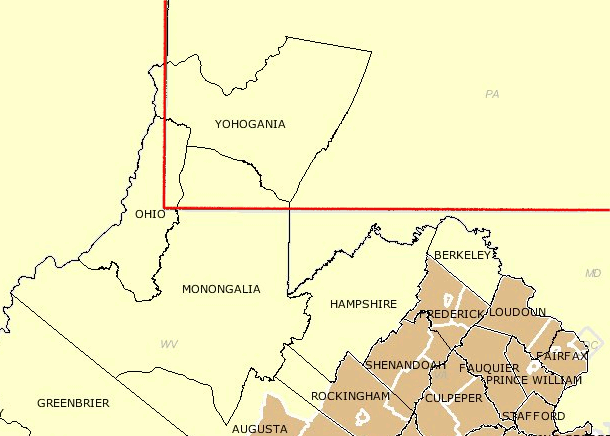
trespass of Yohogania, Monongalia, and Ohio counties into Pennsylvania
Source: Newman Library - Atlas of Historical County Boundaries
As a result of the overlapping Pennsylvania and Virginia claims:13
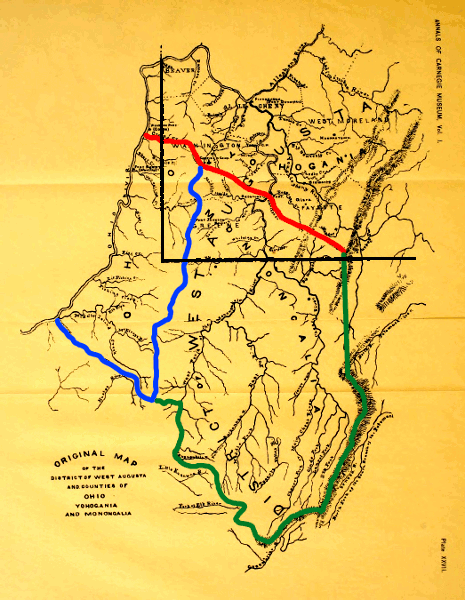
the District of West Augusta, created in 1775, was carved up into three counties in 1776: Yohogania County (in red), Monongalia County (in green), and Ohio County (in blue)
Source: The Boundary Controversy between Pennsylvania and Virginia, 1748-1785, by Boyd Crumrine in Annals of the Carnegie Museum, Vol. 1 (1901) (opposite p.518)
Overlapping jurisdiction meant that property rights were very, very confused. One scholar has noted:14
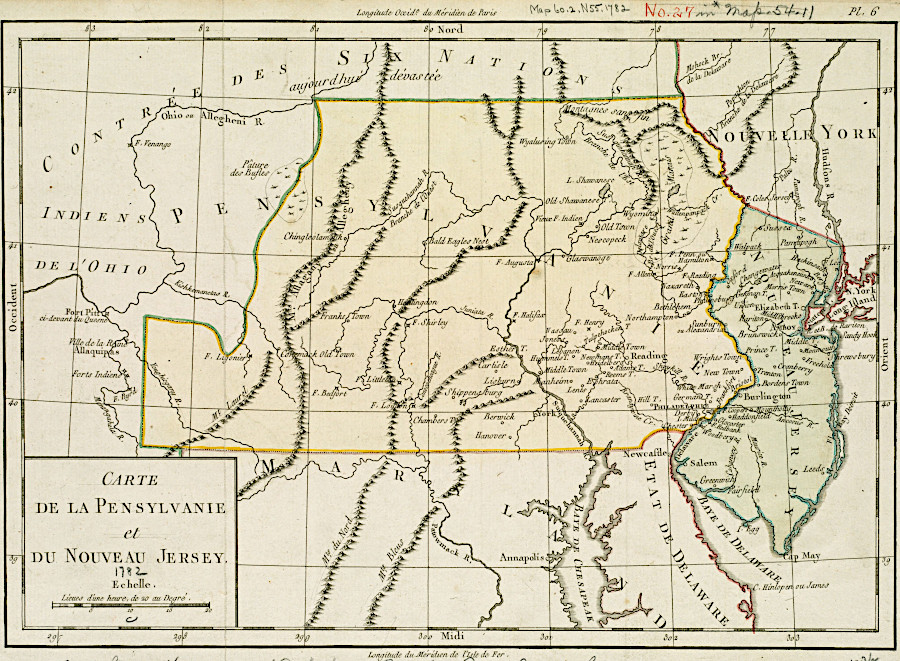
whether Fort Pitt (Pittsburgh) was in Pennsylvania or Virginia was in question, until the two states settled their boundary dispute
Source: Boston Public Library, Norman B. Leventhal Map Center, Carte de la Pensylvanie et du Nouveau Jersey (by Michel-Rene Hilliard d'Auberteuil, 1782)
The continuing conflict among states supposedly united to fight the British during the Revolutionary War was a concern to the Continental Congress, as was the difficulty created in managing relations with Native American tribes on the frontier. Had the British won the war the Grand Ohio Company's dream of a new colony of Vandalia might have been realized.

in 1776, Virginia and Pennsylvania made competing proposals at the Continental Congress for locating a temporary boundary
Source: Library of Virginia, Resolution regarding the Pennsylvania-Virginia boundary, 1776 June 15
To resolve the territorial dispute, in 1776 the settlers in the area petitioned the Continental Congress to create a new state of Westsylvania. That request was similar to efforts by residents in western North Carolina to create the State of Franklin, a separate jurisdiction independent from both Virginia and North Carolina. In both cases, Virginia and the other states involved were able to prevent the loss of their western land claims by blocking the creation of new states.15
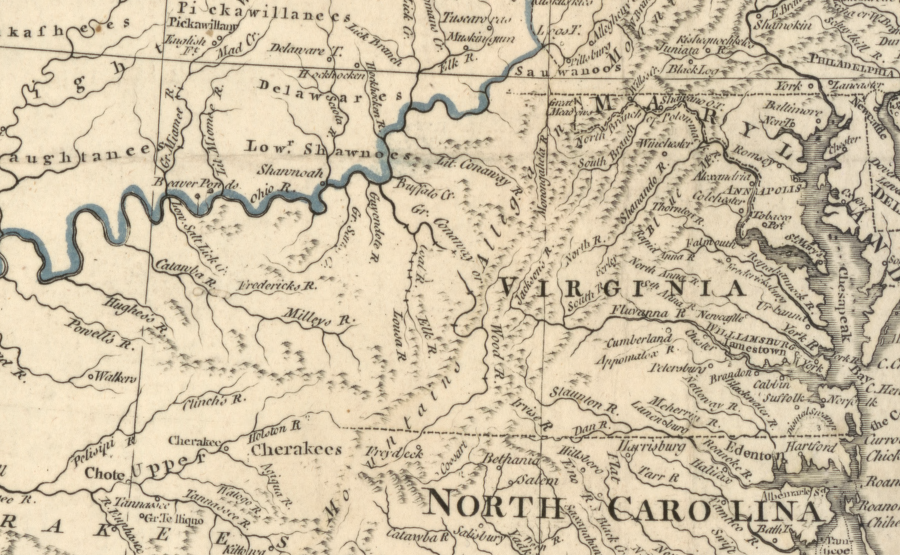
mapmakers right after the American Revolution were vague regarding the western boundaries for Virginia and Pennsylvania
Source: Library of Congress, The United States of North America, with the British & Spanish territories according to the treaty (by William Faden, 1783)
In 1779, Pennsylvania and Virginia appointed commissioners to negotiate a deal. They met in Baltimore, mid-way between each state on "neutral" ground.
Pennsylvania attempted to move the line south to the 39th parallel of latitude. Virginia sought to move the boundary north of the Mason-Dixon line to the 40th parallel. Both ideas were dropped when the commissioners agreed to use the line already defined by Mason and Dixon. The southern boundary of Pennsylvania would stop at a point five degrees west of the Delaware River, at a location beyond where Mason and Dixon had stopped their survey but at the same latitude.
Virginia insisted that pre-existing land claims by individuals be protected. Pennsylvania agreed to grant title to claimants when surveys were completed and filed in local county - Pennsylvania county - courts.16
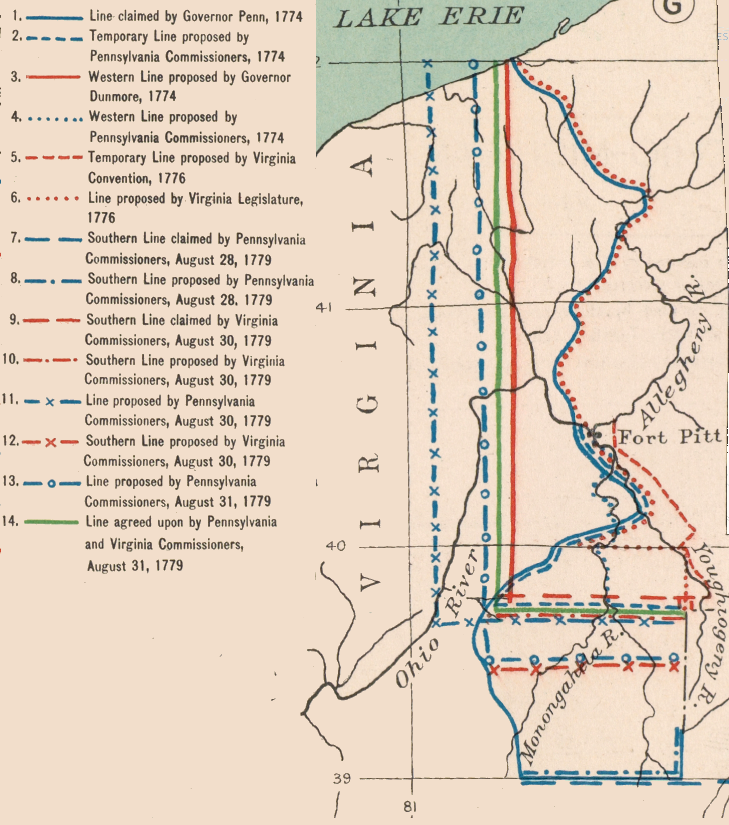
multiple proposals were made between 1774-1779 for defining Pennsylvania's border with Virginia
Source: Atlas of the Historical Geography of the United States, Pennsylvania-Virginia Boundary (Plate 97g) digitized by University of Richmond
The western extension of the Mason-Dixon line was surveyed initially by Alexander McClean of Pennsylvania and Joseph Neville of Virginia in 1782. That survey was done after General Cornwallis had surrendered at Yorktown, but while Britain and America were still officially at war.
From the western endpoint of the extended Mason-Dixon line, the commissioners decided that the western edge of Pennsylvania (the boundary with Virginia) would be a straight line running north. If the western edge paralleled the eastern boundary, located five degrees east and following the Delaware River, then the Virginia-Pennsylvania boundary north of the extended Mason-Dixon line would have curved back and forth. The Delaware River curved eastward at the latitude of the Forks of the Ohio, so Fort Pitt would have become part of Virginia again.
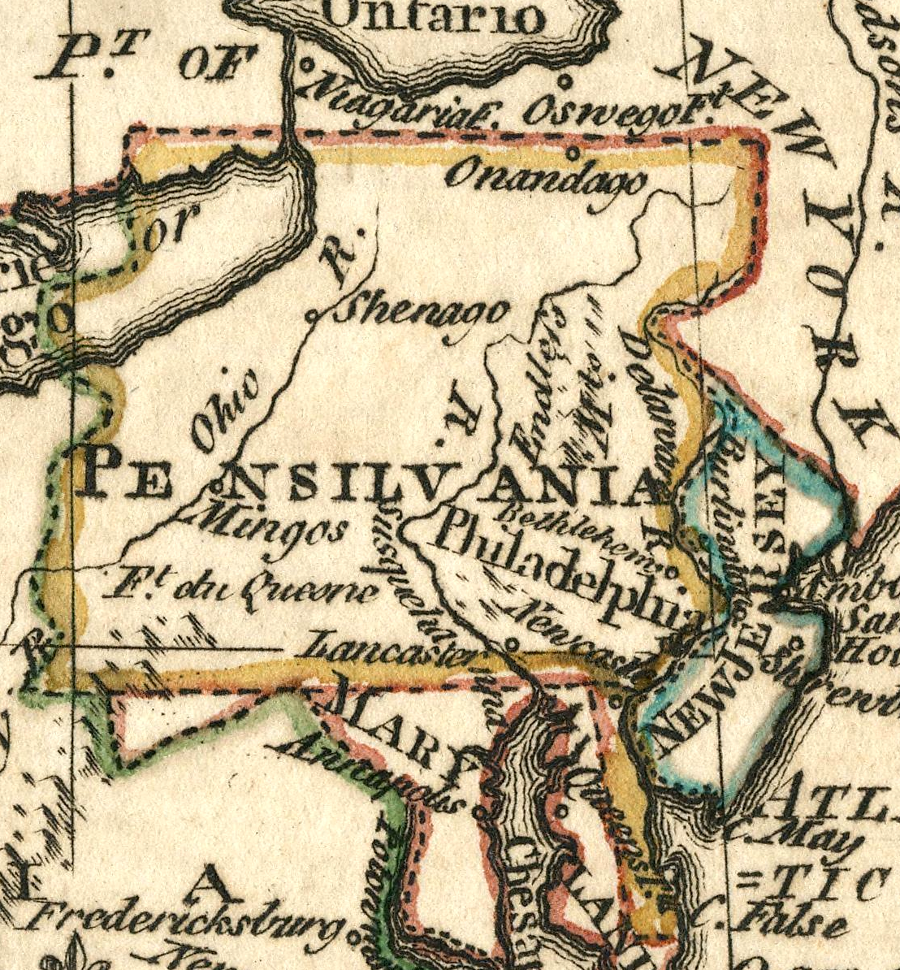
Pennsylvania ended up with less territory than it initially claimed on its northern, eastern, and southern boundaries, but on the western boundary the final straight north-south line (unlike the proposed boundary shown above) expanded its size
Source: David Rumsey Historical Map Collection, Pennsylvania, Maryland And Virginia (by Emanuel Bowen, 1758)
Pennsylvania ended up with control of the transportation corridor between the Susquehanna and Ohio rivers, including the road cut by General John Forbes in 1757 in the campaign to expel the French from Fort Duquesne (Pittsburgh).
Virginia ended up with control of much of the transportation corridor between the Potomac and Ohio rivers, and ultimately built turnpikes and railroads that reached the Ohio River at Parkersburg and Wheeling. However, much of the road cut by General Braddock in 1755 ended up inside Pennsylvania.

the boundaries of Pennsylvania ended up giving that state control over land and water access to the Forks of the Ohio (Pittsburgh)
Source: Wikipedia, Forbes Road
If the Chesapeake and Ohio (C&O) Canal had built past Cumberland and wanted to use the Youghiogheny River as the pathway to the Ohio River, then Maryland and Virginia would have needed approval from Pennsylvania. That state's legislature may not have wanted to enhance the ability of the ports of Alexandria and Baltimore to compete for trade with Philadelphia.17
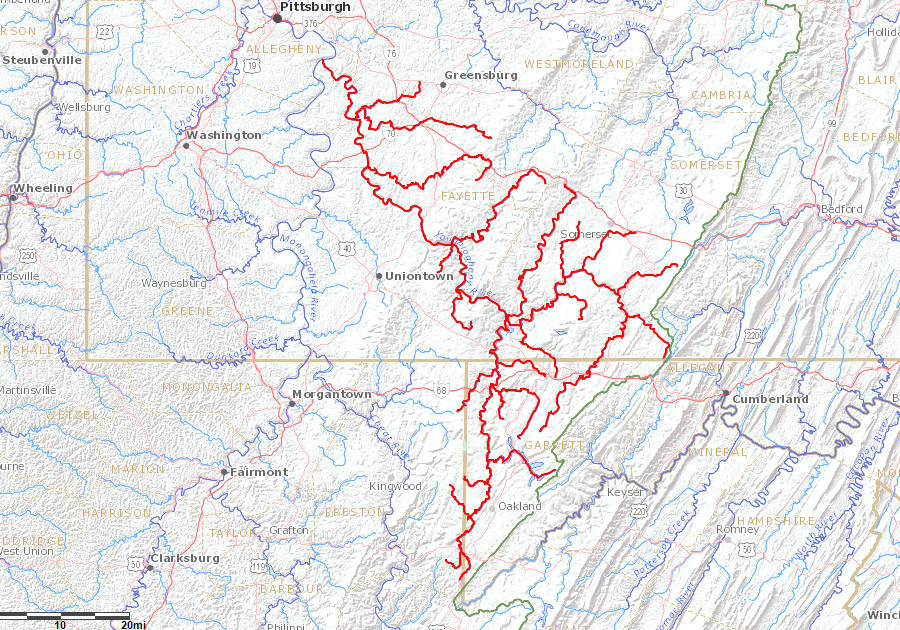
the Youghiogheny River offered one possible route for the C&O Canal to reach the Ohio River
Source: US Geological Survey (USGS), Streamer
After the Virginia-Pennsylvania boundary was defined, including the north-south line defining the western edge of Pennsylvania, Virginia altered the boundaries of two counties. The eastern edges of Monongalia and Ohio counties were revised, reducing the size of those jurisdictions and excluding the land that was located east across the boundary inside Pennsylvania.
Virginia abolished Yohogania County. The small portion of the county that lay outside of Pennsylvania was incorporated into Ohio County, Virginia. Yohogania County's court records, particularly the land deeds, were transferred to Westmoreland County, Pennsylvania.18
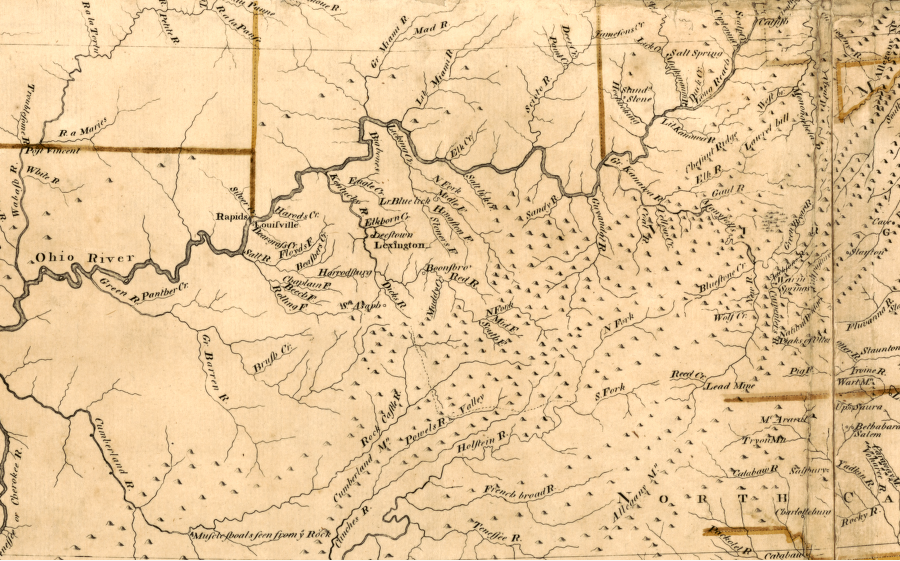
one of the first maps issued after the end of the American Revolution finessed the western boundaries of Virginia and Pennsylvania by omitting them completely
Source: Library of Congress, The United States according to the definitive treaty of peace signed at Paris Sept. 3d. 1783 (William McMurray, 1784)
A permanent Virginia-Pennsylvania survey was finalized in 1784-86. It defined the line north from Pennsylvania's southwestern corner, which had been drawn initially by Alexander McClean of Pennsylvania and Joseph Neville in 1782, to the Ohio River.
That Pennsylvania-Virginia border lasted until 1863. When the western counties of Virginia became the separate state of West Virginia, the Virginia-Pennsylvania boundary disappeared and was replaced by the West Virginia-Pennsylvania boundary.
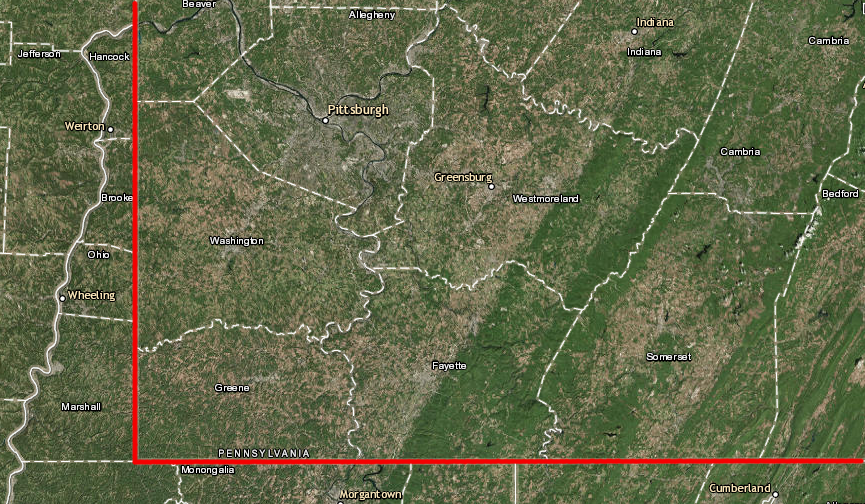
the current Pennsylvania-West Virginia-Maryland boundary is a straight line that was adopted only after a twisting path of many disputes in the 1700's
Source: ESRI,
ArcGIS Online
By the time the western edge of Pennsylvania, "five degrees in longitude... from the said Easterne Bounds" was finally surveyed, the Continental Congress had passed the Land Ordinance of 1785. It outlined how the lands across the Ohio would be surveyed and sold to settlers in an orderly process; rectangular boundary surveys would be completed before the government's land would be sold.
The confusion created by the overlapping claims of Pennsylvania and Virginia was just one of many demonstrations that a new approach to settlement was required. The traditional approach triggered excessive legal disputes.
The "survey before sale" approach and the creation of the Public Land Survey System by the national government replaced the traditional metes-and-bounds surveys done in the past, after settlers selected the best lands and excluded undesired segments of land. The initial surveys of township, range, and section boundaries started in the territory that had been disputed by Pennsylvania and Virginia.
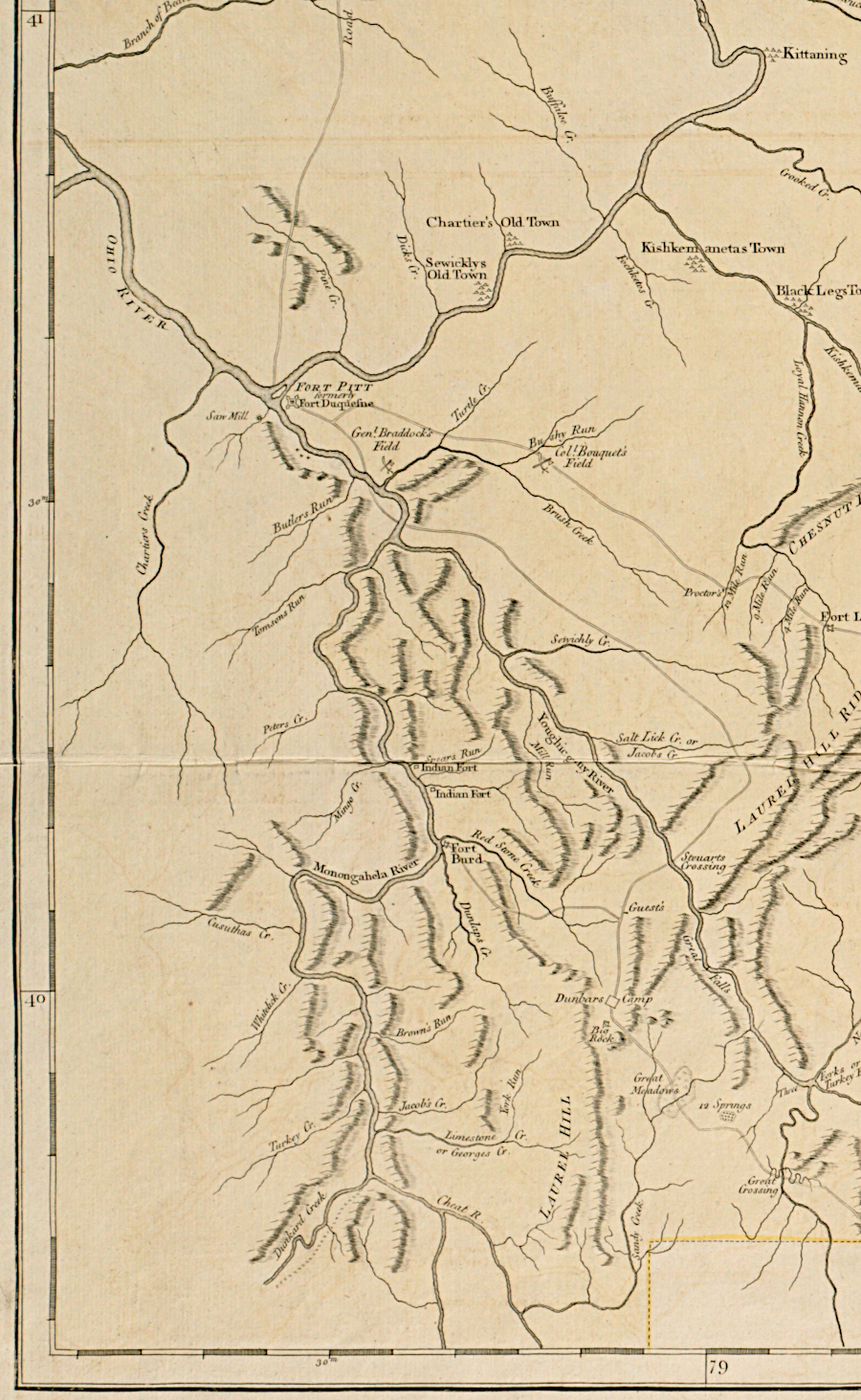
Fort Pitt was clearly within the boundaries of Pennsylvania - at least according to Pennsylvania officials
Source: Norman B. Leventhal Map & Education Center, A map of Pennsylvania exhibiting not only the improved parts of that Province, but also its extensive frontiers (1775)
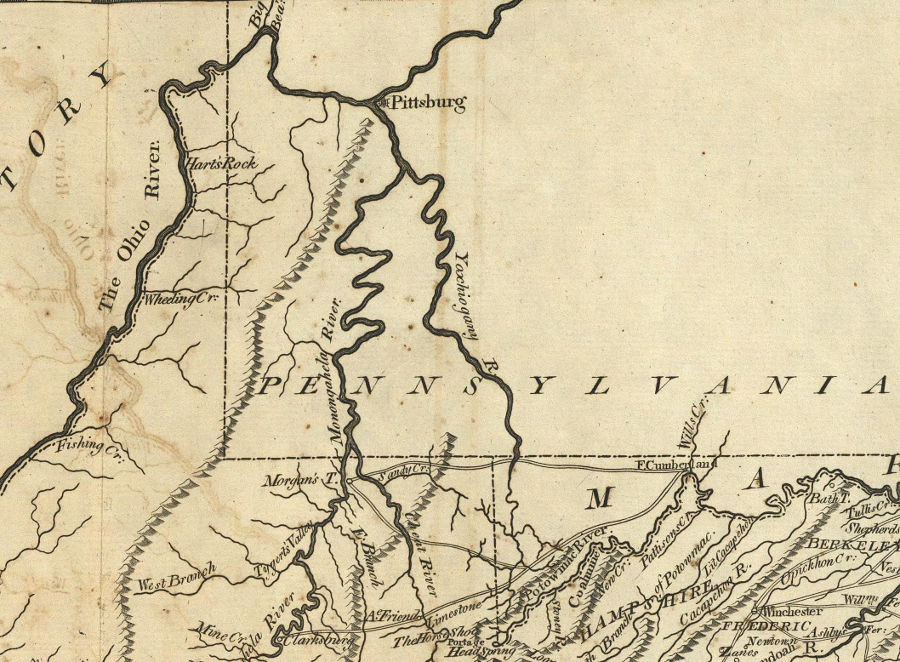
the Virginia-Pennsylvania border was based on straight lines surveyed across the countryside, not on natural boundaries
Source: David Rumsey Historical Map Collection, State of Virginia (by Mathew Carey and Samuel Lewis, 1795)
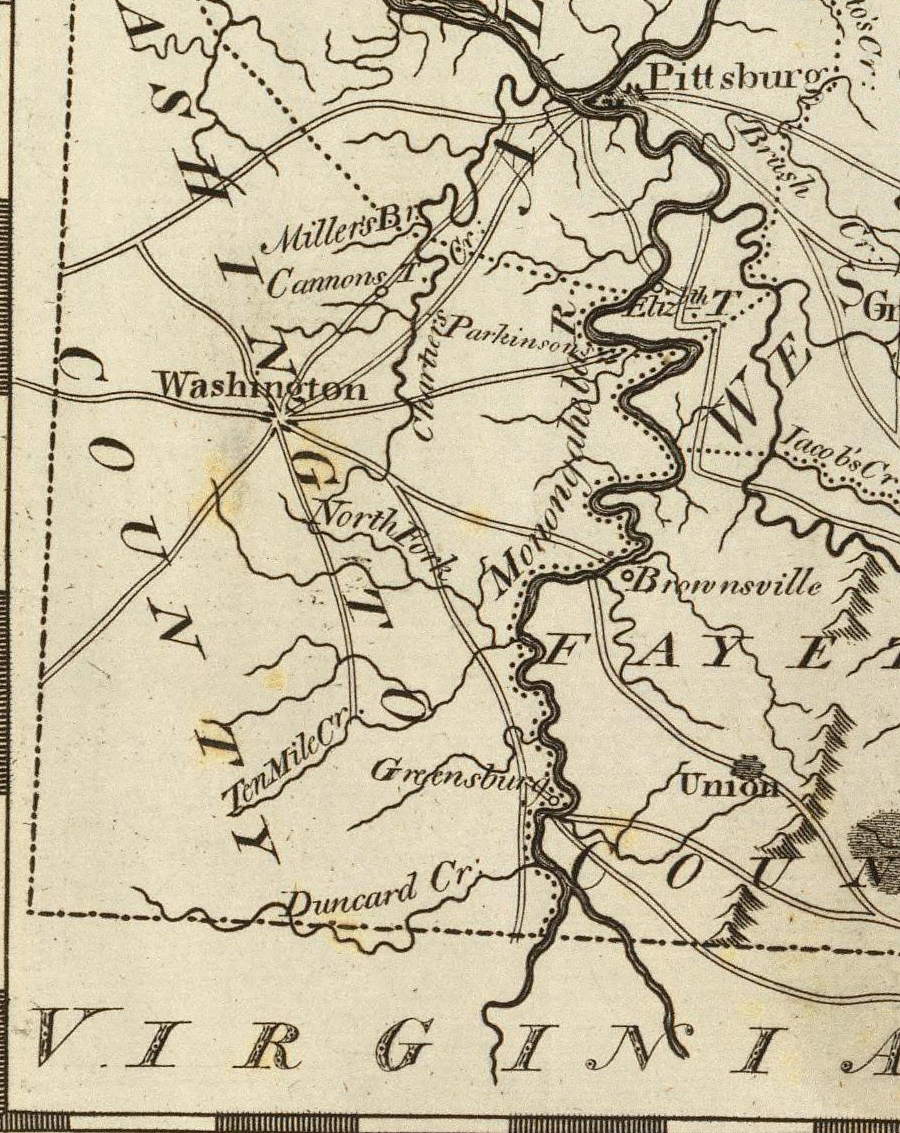
Pennsylvania ended up with Pittsburgh and Washington County
Source: David Rumsey Historical Map Collection, State of Pennsylvania (by Samuel Lewis, 1796)